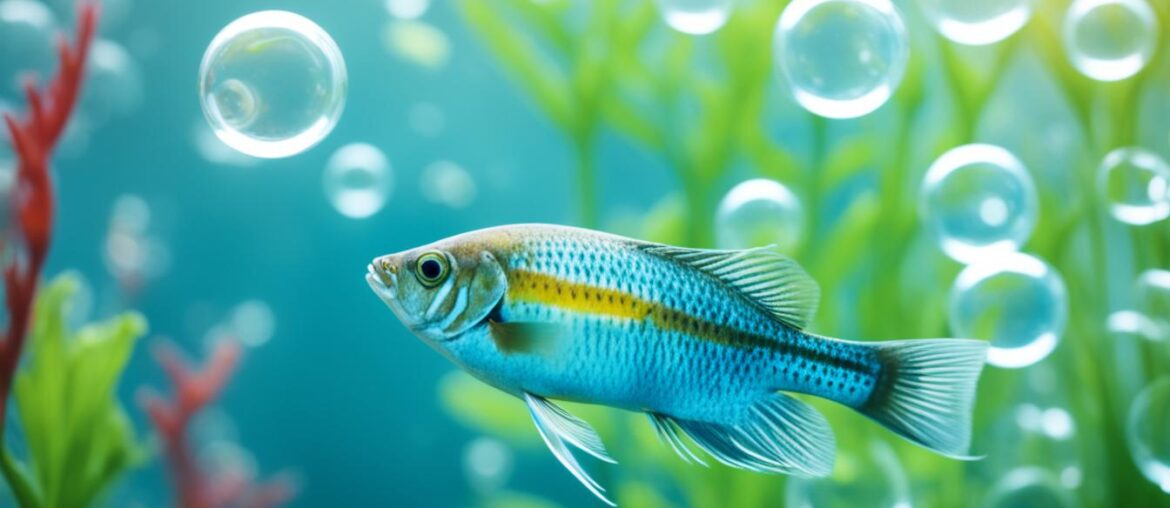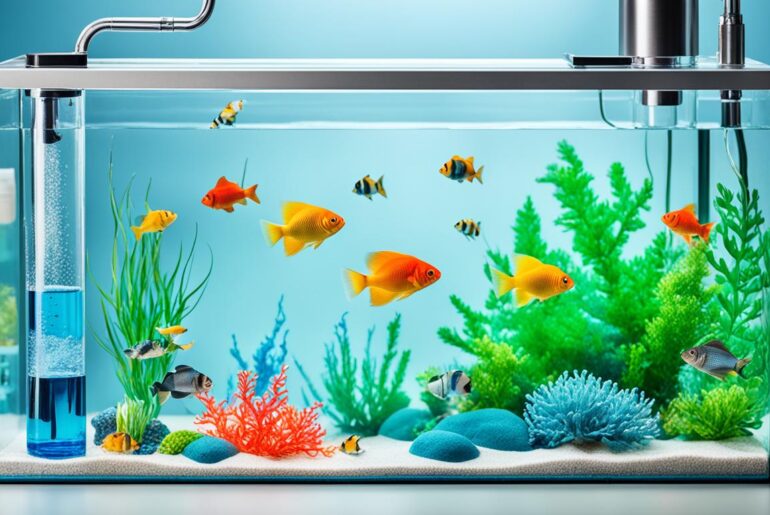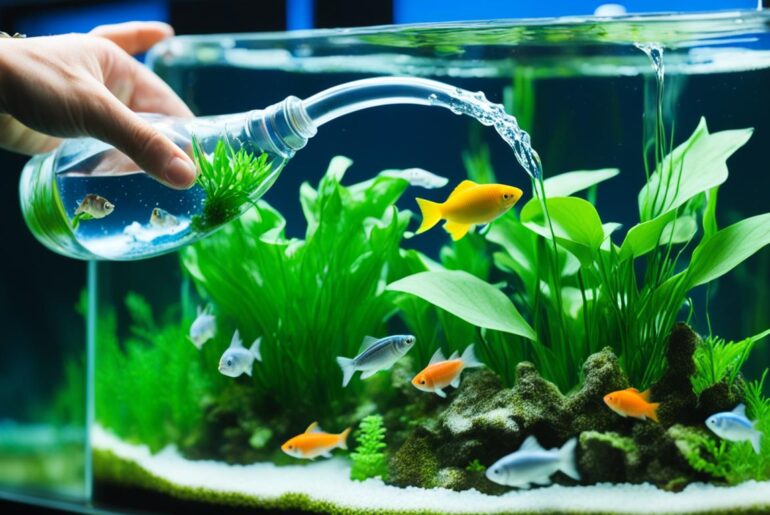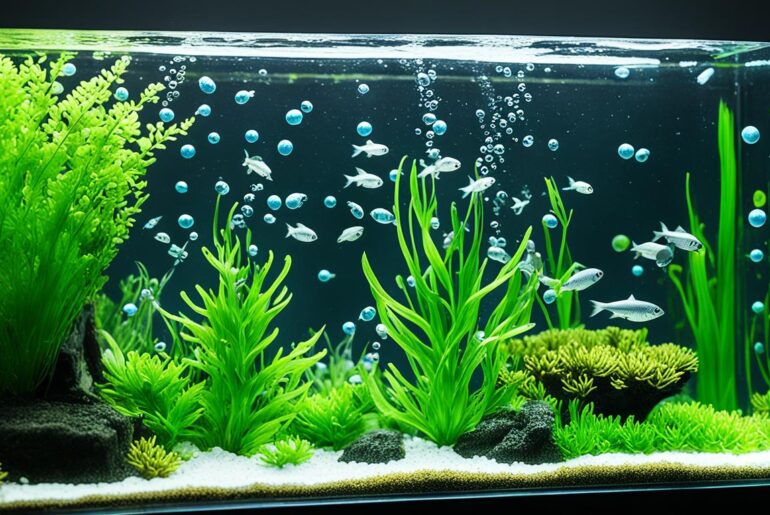Have you ever been so excited to start a new aquarium, only to find yourself stuck in the seemingly endless wait of the cycling process? I was right there with you. My name is Emily, and I’ve been an avid aquarium enthusiast for years. But it wasn’t until I discovered these 5 tips for speeding up the aquarium cycling process that I truly fell in love with this hobby all over again.
When I first started out, I found myself impatiently waiting for weeks, even months, for my tank to cycle before I could add fish. It felt like an eternity, and I was beginning to lose hope. That’s when I decided to do some research and find a way to make the process faster and more efficient.
Through trial and error, I discovered techniques and strategies that not only cut down the cycling time but also created a healthier and more vibrant environment for my fish. I couldn’t believe the difference it made, not only in the speed at which I could add fish to my tank but also in the overall health and well-being of my aquatic friends.
In this article, I want to share these 5 tips with you. Whether you’re a beginner just starting out or a seasoned aquarium hobbyist looking to speed up the cycling process, these tips will help you create a thriving aquarium in no time.
Key Takeaways:
- Implementing these 5 tips can significantly reduce the time it takes for your aquarium to cycle.
- Speeding up the cycling process results in a healthier environment for your fish.
- These tips are relevant for both beginner and experienced aquarium enthusiasts.
- By following these strategies, you can create a thriving aquarium with ease.
- Don’t let the cycling process hold you back from enjoying your aquarium to the fullest.
The Myth of the Instant Cycle
Many aquarium enthusiasts fall into the beginner trap of believing in the concept of an instant cycle for their tanks. These products and techniques claim to provide a quick and convenient way to establish a fully functional aquarium in a matter of hours or days. However, it’s important to understand the reality behind these claims to avoid potential harm to your aquatic pets.
One common method that falls under this category is the Fish-in Cycle. This approach involves adding fish to a newly set up tank immediately, relying on the fish waste to kickstart the nitrogen cycle. While it may seem like a convenient way to cycle your aquarium, it poses significant risks to the health of your fish. The presence of ammonia and nitrites, which are toxic to fish, can still be detected in the water, even though they may be at low levels. This can lead to stress, illness, and even death for your fish.
It’s important to remember that the process of establishing a fully cycled and safe aquarium takes time. The nitrogen cycle is a natural biological process that cannot be rushed or bypassed without consequences. Patience is key to ensuring the well-being of your aquatic pets.
“The Fish-in Cycle can be detrimental to the health of your fish and should be avoided. It’s always best to provide a safe and stable environment for your fish from the start.”
Focus on the Basics
When it comes to speeding up the aquarium cycling process, it’s important to focus on the basics. By paying attention to certain key elements, you can create a healthy environment for your fish and accelerate the cycling process. Here are some essential aspects to consider:
- Maintain a Suitable pH Level: Keeping the pH of your aquarium above 7 is crucial for the well-being of your fish and the establishment of beneficial bacteria. Use a pH testing kit regularly to monitor and adjust the pH level as necessary.
- Ensure Proper Filtration: Filters play a vital role in maintaining water clarity and removing debris and pollutants. It’s important to have your filters always turned on to ensure optimal water quality.
- Use a Dechlorinator: Tap water often contains harmful chemicals that can be detrimental to fish health. Using a dechlorinator is essential to neutralize chlorine and chloramines present in tap water before adding it to your aquarium.
- Maintain the Right Heating Temperature: Temperature plays a crucial role in the cycling process. Keeping the water temperature between 65 and 85 degrees Fahrenheit creates an ideal environment for the growth of beneficial bacteria.
By focusing on these fundamental aspects, you can create a favorable environment for the growth of beneficial bacteria and speed up the cycling process in your aquarium.
“By maintaining the pH, ensuring proper filtration, using a dechlorinator, and maintaining the right heating temperature, you set the foundation for a successful aquarium cycling process.”
Now, let’s take a look at the following table, which summarizes the importance of these basic elements in accelerating the aquarium cycling process:
| Basics | Importance |
|---|---|
| pH | Keeps water conditions favorable for beneficial bacteria growth. |
| Filter | Removes debris and maintains water clarity. |
| Dechlorinator | Neutralizes harmful chemicals in tap water. |
| Heating | Creates an optimal temperature range for bacteria growth. |
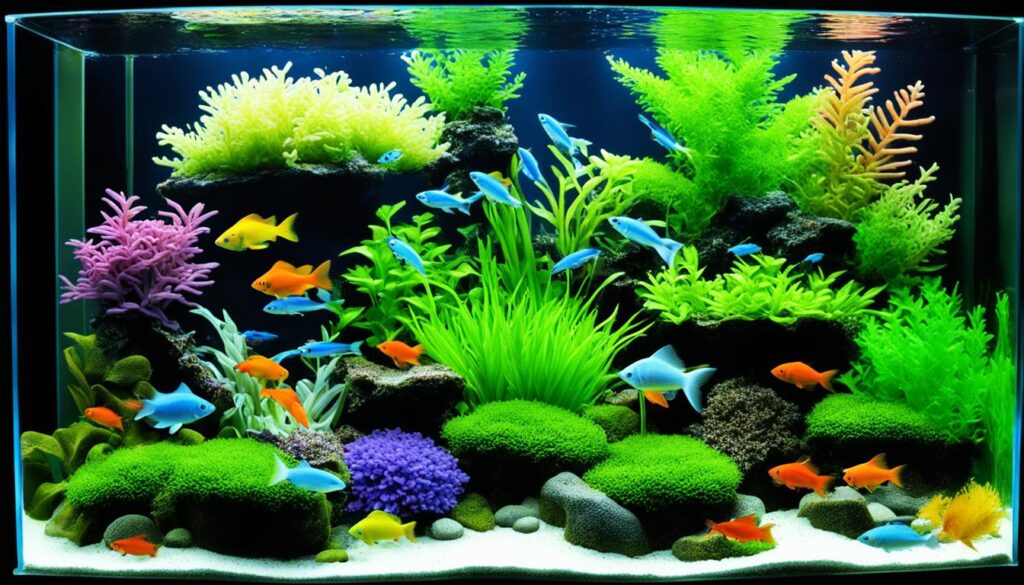
By following these basic principles, you can ensure a healthy environment for your fish and speed up the cycling process, bringing you closer to enjoying a vibrant and thriving aquarium.
Rob an Old Tank
When it comes to speeding up the aquarium cycling process, there’s a trick that can give you a head start – robbing an old tank! By introducing beneficial bacteria from a cycled tank, you can jumpstart the cycling process and create a healthy environment for your fish.
There are a few ways to achieve this. First, you can use a cycled filter from an established tank. The filter harbors beneficial bacteria that have already gone through the cycling process, helping to rapidly establish a bacterial colony in your tank.
Another option is to add gravel from a cycled tank to your own tank. Gravel acts as a substrate that houses beneficial bacteria, providing a solid foundation for the nitrogen cycle to develop more quickly. By introducing this gravel into your tank, you’re bringing in a rich source of bacteria that can kickstart the cycling process.
You can also consider purchasing plants that have been grown in a cycled tank. These plants carry beneficial bacteria on their leaves and roots, which can help populate your tank with the necessary bacteria for cycling. Plants not only aid in the cycling process but also contribute to the overall health and aesthetics of your aquarium.
By robbing an old tank of its beneficial bacteria through a cycled filter, gravel, or plants, you can significantly reduce the time it takes for your aquarium to cycle. This method provides a natural and effective way to establish the delicate balance of microorganisms needed for a thriving aquatic ecosystem.
Use Bacteria in a Bottle
When it comes to speeding up the aquarium cycling process, there are commercially available products that can be a game-changer. These products contain concentrated nitrifying bacteria in a bottle, which can help kickstart the nitrogen cycle and establish a healthy environment for your fish. This method is especially beneficial for beginners or those who want to accelerate the cycling process.
Some popular brands that offer bacteria in a bottle products include Tetra SafeStart, DrTim’s One and Only, and Microbe Lift Nite-Out II. These products contain live nitrifying bacteria that are essential for breaking down toxic ammonia and nitrites in the tank.
By introducing these bacteria into your aquarium, you can significantly reduce the time it takes to establish a stable nitrogen cycle. This means that your tank will be ready for fish sooner, allowing you to enjoy your aquatic pets without the long wait.
Using bacteria in a bottle is a simple and effective way to jumpstart the cycling process. These products provide a concentrated dose of beneficial bacteria, eliminating the need to wait for the bacteria to naturally colonize in the tank. It’s like giving your aquarium a head start towards a healthy and balanced ecosystem.
“Adding bacteria in a bottle can save you weeks, if not months, of waiting for your tank to cycle. It’s a convenient solution that ensures the necessary nitrifying bacteria are present from the start.”
Whether you are a beginner or an experienced aquarist, incorporating bacteria in a bottle can be a valuable tool in your aquarium maintenance arsenal. It offers a practical and efficient way to speed up the cycling process and establish a thriving environment for your fish.
In the next section, we will explore the importance of having a good filter in your aquarium and how it contributes to a faster cycling process.
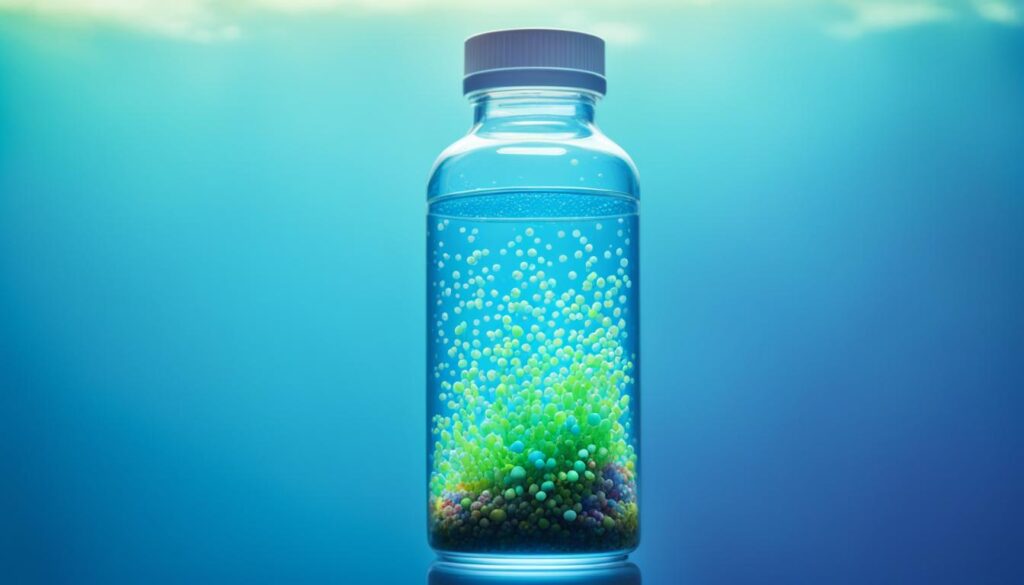
The Importance of a Good Filter
When it comes to speeding up the aquarium cycling process, having a good filter is absolutely crucial. A quality filter plays a vital role in maintaining a healthy and balanced aquatic environment for your fish. Not only does it help to keep the water clean and clear, but it also provides essential biological filtration.
One of the key features to look for in a good aquarium filter is ample filter media. Filter media serves as a breeding ground for beneficial bacteria, which are responsible for breaking down harmful substances like ammonia and nitrite. The more surface area available for these bacteria to colonize, the better the filtration efficiency.
In addition to filter media, it’s essential to consider the water flow rate of the filter. A high water flow rate promotes efficient biological filtration by ensuring that water passes through the filter media at a sufficient rate, allowing bacteria to effectively remove toxins. This helps to prevent the buildup of ammonia and nitrite, creating a healthier environment for your fish.
While there are various types of filters available in the market, canister filters are renowned for their effectiveness in providing both ample filter media and a high water flow rate. However, any filter that meets these criteria will work effectively in speeding up the cycling process.
“A good filter is like the heart of your aquarium, continuously working to keep the water clean and toxin-free.”
The Image below illustrates the importance of a good filter:

| Filter Features | Benefits |
|---|---|
| Ample Filter Media | Provides surface area for beneficial bacteria to colonize |
| High Water Flow Rate | Promotes efficient biological filtration by ensuring proper water circulation |
Adjust Parameters for Optimal Bacteria Growth
To promote optimal bacteria growth during the cycling process, it is important to pay attention to certain parameters that can enhance the environment for beneficial bacteria. Adjusting these factors can help accelerate the establishment of a healthy nitrogen cycle in your aquarium.
Firstly, maintaining the correct water temperature is crucial. I recommend raising the water temperature to a range of 84-85 degrees Fahrenheit. This slightly higher temperature provides an ideal environment for bacteria growth and promotes their activity in breaking down ammonia and nitrites.
In addition to temperature, it is essential to ensure an adequate level of dissolved oxygen in the water. This can be achieved by using air stones and increasing the output of your aquarium air pump. By doing so, you enhance the oxygen levels in the water, facilitating the metabolic activities of the beneficial bacteria.
Lastly, it is important to keep nitrate levels low during the cycling process. Excessive nitrate concentration can create an acidic environment that inhibits bacterial growth. Regular water testing and partial water changes can help maintain nitrate levels within the recommended range.
Remember, by adjusting the water temperature, increasing dissolved oxygen levels, and keeping nitrate concentrations low, you create an optimal environment for the growth and activity of beneficial bacteria, accelerating the cycling process in your aquarium.
Now let’s take a look at the table below, which summarizes the recommended adjustments for optimal bacteria growth:
| Parameter | Adjustment |
|---|---|
| Water Temperature | 84-85 degrees Fahrenheit |
| Dissolved Oxygen Level | Use air stones and increase aquarium air pump output |
| Nitrate Concentration | Maintain low levels through water testing and partial water changes |
By implementing these adjustments, you can create an optimal environment for the growth of beneficial bacteria, allowing for a faster and more successful cycling process for your aquarium.
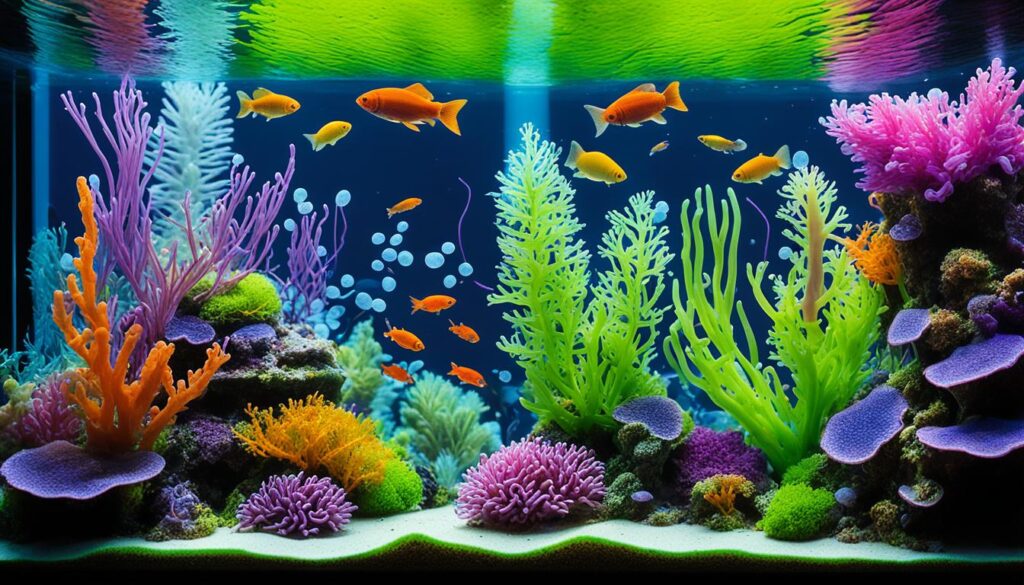
Additional Tips for a Faster Cycling Process
When it comes to speeding up the cycling process, there are a few additional tips that can make a difference. Consider implementing these strategies to achieve a faster and more efficient cycle for your aquarium.
- Use Calcium Substrate: Incorporating a calcium substrate into your tank during the cycling process can help create a more stable environment for beneficial bacteria to thrive. This substrate not only provides essential minerals but also helps maintain proper pH levels in the water.
- Measure Ammonia Levels: If you are using live sand in your tank, it is crucial to regularly measure ammonia levels. Live sand contains dormant bacteria that can release ammonia during the cycling process. Monitoring ammonia levels will help you ensure they remain within acceptable ranges for the health of your tank.
- Avoid Factors that Promote Competitor Growth: To give the beneficial bacteria the best chance to colonize your tank, it’s essential to avoid factors that promote the growth of competitors. This includes minimizing exposure to light, avoiding the use of GFO (Granular Ferric Oxide), and organic carbon dosing during the cycling process. By reducing the growth of competitors, you create a more favorable environment for the beneficial bacteria to establish themselves.
- Maintain a Higher Water Temperature: Keeping the water temperature slightly higher during the cycling process can help speed up bacterial growth. Aim for a temperature range of 78-82 degrees Fahrenheit (25-28 degrees Celsius) to provide optimal conditions for the beneficial bacteria to thrive.
To summarize, incorporating calcium substrate, monitoring ammonia levels when using live sand, avoiding factors that promote competitor growth, and maintaining a higher water temperature can all contribute to a faster and more efficient aquarium cycling process.
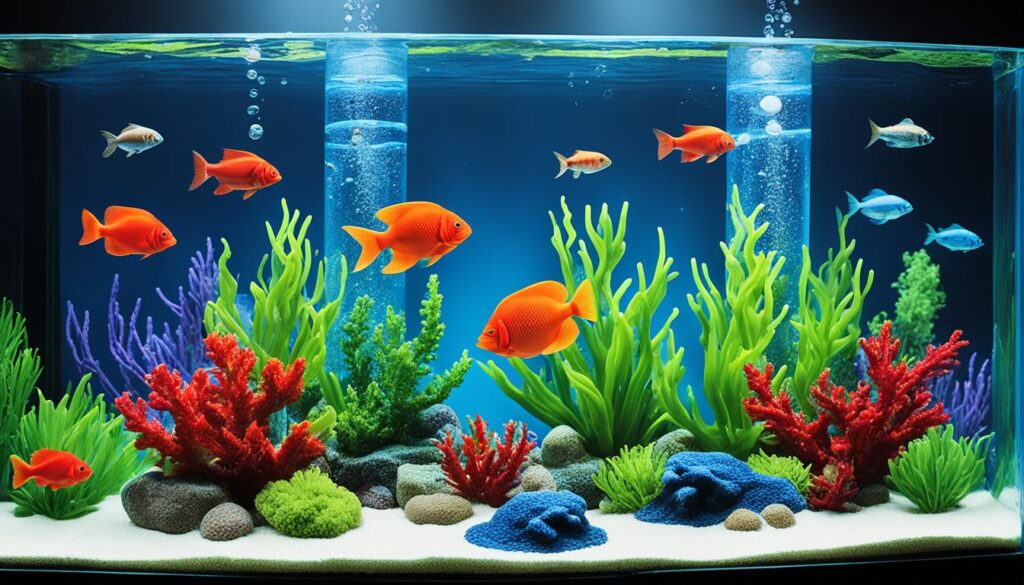
Monitor Ammonia and Nitrite Levels
Throughout the cycling process, it is crucial to regularly monitor the levels of ammonia and nitrite in your aquarium. This can be easily done using water testing kits, which are readily available at pet stores or online. By keeping a close eye on these levels, you can ensure the health and well-being of your aquatic ecosystem.
Why are ammonia and nitrite levels important?
During the cycling process, beneficial bacteria in your tank work to convert harmful ammonia produced by fish waste into nitrite, and then into less toxic nitrate. Monitoring ammonia and nitrite levels allows you to assess the progress of bacterial colonization and ensure that the nitrogen cycle is functioning effectively.
How to maintain optimal levels:
To maintain a healthy aquarium, it is important to keep ammonia and nitrite levels below 5mg/L. Higher levels can be harmful to your fish and other aquatic inhabitants. Additionally, it is essential to dose the minimum required amount of ammonia, as overdosing can hinder the establishment of beneficial bacteria. Regularly monitoring and adjusting these levels will help create a stable and safe environment for your aquatic pets.
Partial water changes:
In addition to monitoring ammonia and nitrite levels, performing partial water changes can play a crucial role in maintaining a healthy nitrogen cycle. These water changes help reduce excessive nitrate levels that can accumulate over time. Additionally, they restore the water buffer, maintaining stable pH levels and preventing potential fluctuations that can stress your fish. Regular partial water changes, typically around 25%, can make a significant difference in the overall water quality and the well-being of your aquatic inhabitants.
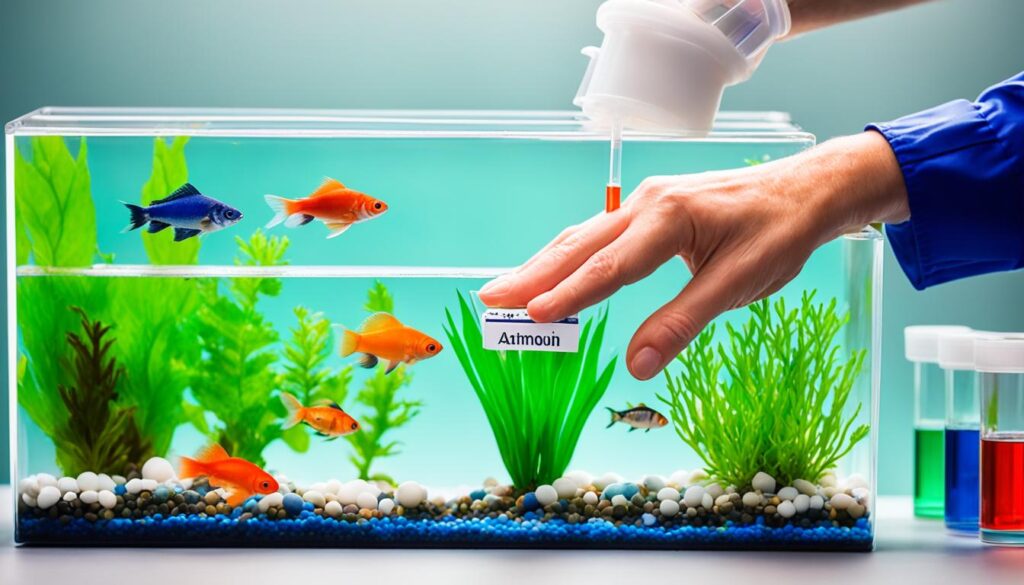
| Parameter | Ideal Range |
|---|---|
| Ammonia | Below 5mg/L |
| Nitrite | Below 5mg/L |
Conclusion
Speeding up the aquarium cycling process is possible by following these tips and methods. While the exact time required for the cycling process may vary, implementing these strategies can significantly shorten the time it takes for your tank to be ready for fish. By focusing on the basics, such as maintaining the pH levels, using a filter and dechlorinator, and ensuring proper heating, you can create a healthy foundation for your aquarium.
Introducing beneficial bacteria from a cycled tank and using products like Tetra SafeStart, DrTim’s One and Only, or Microbe Lift Nite-Out II can help establish a thriving ecosystem more quickly. Having a good filter, with ample filter media for bacteria colonization and efficient biological filtration, is crucial. Adjusting parameters like water temperature, dissolved oxygen levels, and nitrate concentrations can further optimize bacteria growth.
Throughout the cycling process, it is essential to monitor ammonia and nitrite levels using water testing kits. Keeping these levels in check and performing partial water changes when necessary will help maintain a healthy environment for your fish. By following these guidelines, you can create an optimal environment for a faster and successful aquarium cycling process, providing your fish with a safe and thriving home.
FAQ
What is the myth of the instant cycle?
The instant cycle is a misleading claim that suggests you can add fish to your aquarium the same day you set it up. However, even with instant cycling products, low levels of ammonia and nitrites may still be present, making it unsafe for fish. It is essential to understand that there is no instant cycle for an aquarium.
What basics should I focus on for a faster aquarium cycling process?
To speed up the cycling process, focus on maintaining a pH above 7, ensuring your filters are always turned on, using a dechlorinator to remove harmful chemicals from tap water, and maintaining the proper heating temperature between 65 and 85 degrees Fahrenheit.
How can I introduce beneficial bacteria to speed up the cycling process?
You can introduce beneficial bacteria by using a cycled filter from an established tank, adding gravel from a cycled tank to your own tank, or purchasing plants that have been grown in a cycled tank. These methods help introduce the necessary bacteria for cycling.
Are there bacteria in a bottle products that can help speed up the cycling process?
Yes, there are commercially available products that contain concentrated nitrifying bacteria, such as Tetra SafeStart, DrTim’s One and Only, and Microbe Lift Nite-Out II. These products can significantly speed up the cycling process by introducing live bacteria to your tank, helping to establish the nitrogen cycle more quickly.
How important is having a good filter for a faster cycling process?
Having a good filter is crucial for speeding up the cycling process. A good filter should have ample filter media for the bacteria to colonize and a high water flow rate for efficient biological filtration. Canister filters are known for their effectiveness in providing both of these features, but any filter that meets these criteria will work.
How can I adjust parameters to promote optimal bacteria growth during the cycling process?
To promote optimal bacteria growth, raise the water temperature to 84-85 degrees Fahrenheit, increase the dissolved oxygen level by using air stones and turning up the aquarium air pump, and keep nitrate levels low to prevent an acidic environment that hinders bacterial growth.
Are there any additional tips for a faster cycling process?
Yes, consider using calcium substrate during the cycle, measuring ammonia levels when using live sand, avoiding factors that promote the growth of competitors (such as turning off lights, avoiding GFO and organic carbon dosing), and maintaining a higher water temperature during the cycle.
How important is it to monitor ammonia and nitrite levels during the cycling process?
It is crucial to monitor ammonia and nitrite levels using water testing kits throughout the cycling process. Keep ammonia and nitrite levels below 5mg/L and only dose the minimum required amount of ammonia. Doing partial water changes can help reduce excessive nitrate levels and restore the water buffer.
How long will it take to cycle an aquarium using these tips and methods?
The exact time required for the cycling process may vary, but implementing these strategies can significantly shorten the time it takes for your tank to be ready for fish. By focusing on the basics, introducing beneficial bacteria, using bacteria in a bottle, having a good filter, adjusting parameters, and monitoring ammonia and nitrite levels, you can create an optimal environment for a faster and successful aquarium cycling process.
